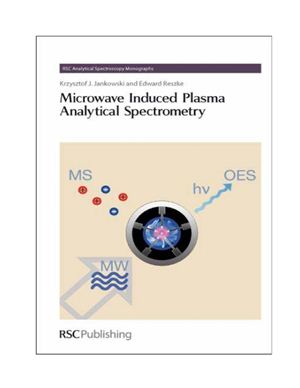The Royal Society of Chemistry, 2011, 248 pages
This book is the most comprehensive recent publication on MIPs, consisting of 13 chapters, primarily involving the fundamentals, the instrumentation, and the methodologies of MIP-OES. The physical and chemical characteristics of the various MIP sources and sample introduction techniques available are all discussed as well as how these characteristics affect the design of the parts of the MIP setup with inclusion of some very recent work with MIP sources. Considerable experimental and fundamental emphasis is placed on the plasma generation as well as the experimental aspects of sample introduction in MIP spectrometry. The book firstly outlines the generation and operation of MIP discharges, and presents briefly the principles of MIP-based techniques currently in use, along with their potential benefits and limitations. It then addresses the art and science of microwave plasma generation and highlights very recent advances in the field, presenting both the fundamental properties and the design details of new microwave plasma sources. Analytical characteristics and novel applications of MIP-OES for a wide variety of sample types are also reviewed. As the book documents the latest achievements in MIP spectrometry, it should stimulate their use on a wider scale in the analytical and research laboratories and will prove useful to manufacturers of analytical instruments. This book is also aimed at academics and postgraduates embarking on work in the field of MIP source spectrometry, ICP/MIP users, analysts and research groups who want to configure their own plasma spectrometry setup, and manufacturers of plasma spectrometers and MIP devices. It will also be a useful source of information for those seeking to interface various sample introduction techniques with plasmas and for all those who would like to know more about the technique.
This book is the most comprehensive recent publication on MIPs, consisting of 13 chapters, primarily involving the fundamentals, the instrumentation, and the methodologies of MIP-OES. The physical and chemical characteristics of the various MIP sources and sample introduction techniques available are all discussed as well as how these characteristics affect the design of the parts of the MIP setup with inclusion of some very recent work with MIP sources. Considerable experimental and fundamental emphasis is placed on the plasma generation as well as the experimental aspects of sample introduction in MIP spectrometry. The book firstly outlines the generation and operation of MIP discharges, and presents briefly the principles of MIP-based techniques currently in use, along with their potential benefits and limitations. It then addresses the art and science of microwave plasma generation and highlights very recent advances in the field, presenting both the fundamental properties and the design details of new microwave plasma sources. Analytical characteristics and novel applications of MIP-OES for a wide variety of sample types are also reviewed. As the book documents the latest achievements in MIP spectrometry, it should stimulate their use on a wider scale in the analytical and research laboratories and will prove useful to manufacturers of analytical instruments. This book is also aimed at academics and postgraduates embarking on work in the field of MIP source spectrometry, ICP/MIP users, analysts and research groups who want to configure their own plasma spectrometry setup, and manufacturers of plasma spectrometers and MIP devices. It will also be a useful source of information for those seeking to interface various sample introduction techniques with plasmas and for all those who would like to know more about the technique.

